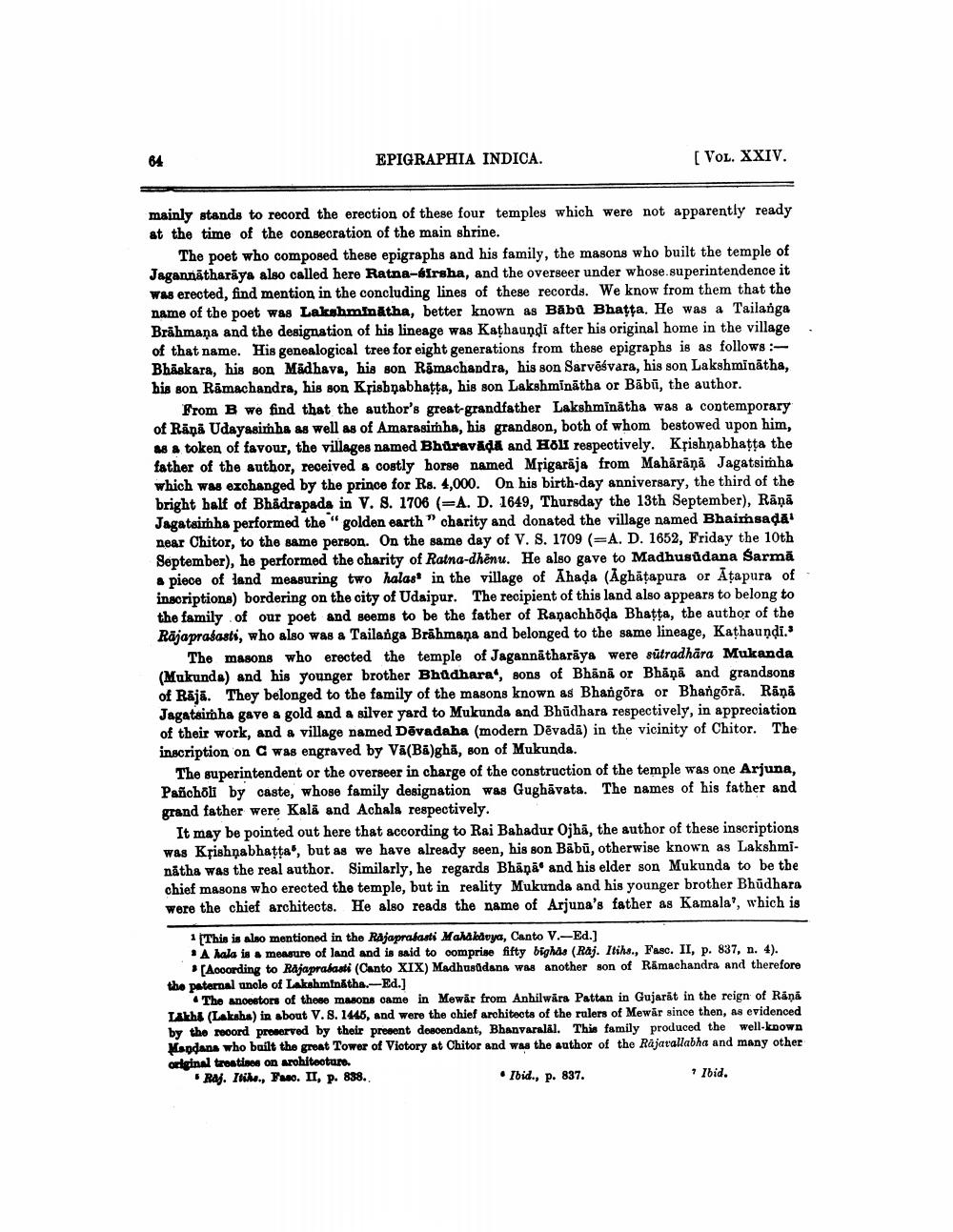________________
EPIGRAPHIA INDICA.
[Vol. XXIV.
mainly stands to record the erection of these four temples which were not apparently ready at the time of the consecration of the main shrine.
The poet who composed these epigraphs and his family, the masons who built the temple of Jagannātharaya also called here Ratna-sIrsha, and the overseer under whose superintendence it Was erected, find mention in the concluding lines of these records. We know from them that the name of the poet was Lakshminátha, better known as Bābū Bhatta. He was a Tailanga Brāhmaṇa and the designation of his lineage was Kathaundi after his original home in the village of that name. His genealogical tree for eight generations from these epigraphs is as follows: Bhāskara, his son Madhava, his son Ramachandra, his son Sarvēśvara, his son Lakshminátha, his son Ramachandra, his son Krishnabhatta, his son Lakshminātha or Bābū, the author.
From B we find that the author's great-grandfather Lakshminātha was a contemporary of Rani Udayasimba as well as of Amarasimha, his grandson, both of whom bestowed upon him, wa token of favour, the villages named Bharavada and Holl respectively. Krishnabhatta the father of the author, received a costly horse named Mpigarāja from Mahārāņā Jagatsimha which was exchanged by the prince for Rs. 4,000. On his birth-day anniversary, the third of the bright balf of Bhadrapada in V. 8. 1706 (=A. D. 1649, Thursday the 13th September), Rāņā Jagatsinha performed the golden earth" charity and donated the village named Bhainsadai near Chitor, to the same person. On the same day of V. S. 1709 (=A. D. 1652, Friday the 10th September), he performed the charity of Ratna-dhënu. He also gave to Madhusudana Sarmā a piece of land measuring two halast in the village of Ahada (Aghätapura or Atapura of inscriptions) bordering on the city of Udaipur. The recipient of this land also appears to belong to the family of our poet and seems to be the father of Ranachböda Bhatta, the author of the Rājaprasasti, who also was a Tailanga Brāhmaṇa and belonged to the same lineage, Kathaundi.
The masons who erected the temple of Jagannatharäys were sutradhāra Mukanda (Mukunda) and his younger brother Bhadhara', sons of Bhänā or Bhāņā and grandsons of Raja. They belonged to the family of the masons known as Bhangöra or Bhangöra. Rāņā Jagatsimha gave a gold and a silver yard to Mukunda and Bhūdhara respectively, in appreciation of their work, and a village named Dēvadaha (modern Dēvadā) in the vicinity of Chitor. The inscription on C was engraved by Vā(Ba)ghā, son of Mukunda.
The superintendent or the overseer in charge of the construction of the temple was one Arjuna, Pancholi by caste, whose family designation was Gughāvata. The names of his father and grand father were Kala and Achala respectively.
It may be pointed out here that according to Rai Bahadur Ojha, the author of these inscriptions was Krishṇabhatta, but as we have already seen, his son Bābū, otherwise known as Lakshminātha was the real author. Similarly, he regards Bhana and his elder son Mukunda to be the chief masons who erected the temple, but in reality Mukunda and his younger brother Bhūdhara were the chief architects. He also reads the name of Arjuna's father as Kamala', which is
This is also mentioned in the Rajaprabasti Malakivya, Canto V.-Ed.) A hala is a measure of land and is said to comprise fifty bighas (Raj. Itihs., Fasc. II, p. 837, n. 4).
[According to Rajaprakasti (Canto XIX) Madhusůdans was another son of Ramachandra and therefore the paternal uncle of Lakshminatha.-Ed.]
The ancestors of these masons came in Mewar from Anhilwara Pattan in Gujarat in the reign of Rana Lakh (Laksha) in about V.8. 1445, and were the chief architects of the rulers of Mewar since then, as evidenced by the rooord preserved by their present descendant, Bhanvaraläl. This family produced the well-known Misodana who built the great Tower of Victory at Chitor and was the author of the Rajarallabha and many other original treatises on arohitecture. . Raj. Itike., P . II, p. 838.
• Ibid., p. 837.
* Ibid.




